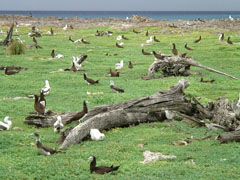February 2012 Expedition - Day 12 - The Three Brothers
The Three Brothers islands on the Great Chagos Bank and a magical place filled with more birds than you would think could fit on the tiny islands. On Middle Brother, a beautiful island with its own large lagoon, at least twenty five thousand Sooty Terns were nesting, as well as Noddy Terns and Red-Footed Boobies. On North Brother, a more challenging island to land on, thousands of Wedge-Tailed Shearwater had nesting burrows in every suitable space on the ground that they could - except for that occupied by the ground-nesting Brown Boobies.
These illustrate how important unspoilt islands are for these birds, as, being ground nesters, they would be completely vulnerable to rats, cats, dogs and of course man. The islands also illustrate another point raised by the expedition ornithologist Pete Carr, that Important Bird Areas (IBAs), of which Chagos has ten, should encompass not single islands but groups of islands. South Brother normally has ten thousand pairs of nesting Sooty Terns, but this year they all seem to have moved to Middle Brother to nest. South Brother this year has no significant numbers of sooty terns nesting on it at the moment, therefore. It would still retain its IBA status, but if the group of islets collectively were one ‘IBA cluster’ then that would make more sense over the years and would cater for such movements.
But I’m getting ahead of myself.

This morning we all dived on the seaward slope off Middle Brother. The water was clear and the dive teams were surrounded by literally thousands and thousands of fish called Rainbow Runners. It was a magnificent sight. The same sorts of recording was done as we have done on several other reefs now, all to build up the amount of data to statistically useful levels.
The BRUVS team were deploying the units to the north of North Brother, well away from the divers, where today and tomorrow mornings they are looking for any difference between using baited versus unbaited units.
In the afternoon two teams worked again on the seaward site and one team dived in the Middle Brother lagoon, more murky and sedimented, but very different to any other known site in this archipelago in terms of its corals and other reef life. This is an interesting location, with four eagle rays, a very large stingray and several large nurse sharks on this occasion. Close to shore, two baby blacktip reef sharks swam by and the divers were again engulfed in a huge school of jacks.
After surfacing we went ashore to photo document the incredible numbers of birds on the islands and the skies above them.

